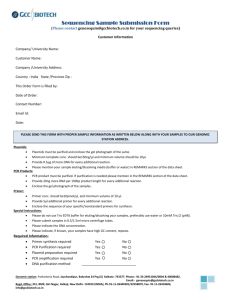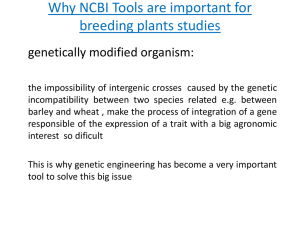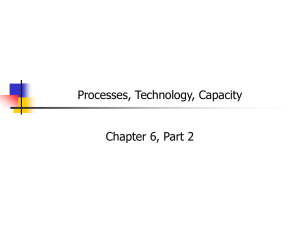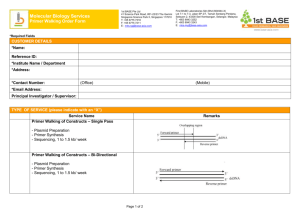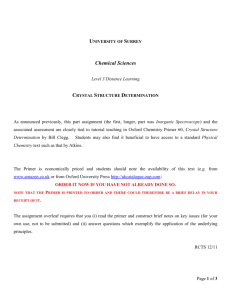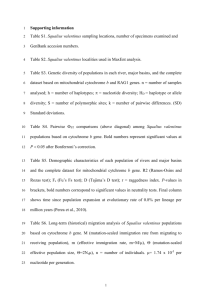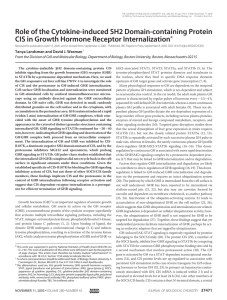Additional file 2
advertisement
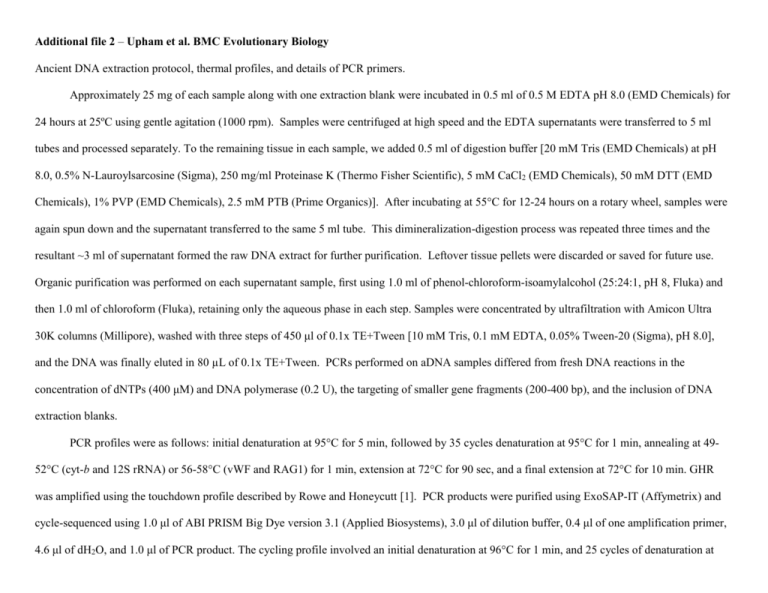
Additional file 2 – Upham et al. BMC Evolutionary Biology Ancient DNA extraction protocol, thermal profiles, and details of PCR primers. Approximately 25 mg of each sample along with one extraction blank were incubated in 0.5 ml of 0.5 M EDTA pH 8.0 (EMD Chemicals) for 24 hours at 25ºC using gentle agitation (1000 rpm). Samples were centrifuged at high speed and the EDTA supernatants were transferred to 5 ml tubes and processed separately. To the remaining tissue in each sample, we added 0.5 ml of digestion buffer [20 mM Tris (EMD Chemicals) at pH 8.0, 0.5% N-Lauroylsarcosine (Sigma), 250 mg/ml Proteinase K (Thermo Fisher Scientific), 5 mM CaCl2 (EMD Chemicals), 50 mM DTT (EMD Chemicals), 1% PVP (EMD Chemicals), 2.5 mM PTB (Prime Organics)]. After incubating at 55°C for 12-24 hours on a rotary wheel, samples were again spun down and the supernatant transferred to the same 5 ml tube. This dimineralization-digestion process was repeated three times and the resultant ~3 ml of supernatant formed the raw DNA extract for further purification. Leftover tissue pellets were discarded or saved for future use. Organic purification was performed on each supernatant sample, first using 1.0 ml of phenol-chloroform-isoamylalcohol (25:24:1, pH 8, Fluka) and then 1.0 ml of chloroform (Fluka), retaining only the aqueous phase in each step. Samples were concentrated by ultrafiltration with Amicon Ultra 30K columns (Millipore), washed with three steps of 450 μl of 0.1x TE+Tween [10 mM Tris, 0.1 mM EDTA, 0.05% Tween-20 (Sigma), pH 8.0], and the DNA was finally eluted in 80 µL of 0.1x TE+Tween. PCRs performed on aDNA samples differed from fresh DNA reactions in the concentration of dNTPs (400 μM) and DNA polymerase (0.2 U), the targeting of smaller gene fragments (200-400 bp), and the inclusion of DNA extraction blanks. PCR profiles were as follows: initial denaturation at 95°C for 5 min, followed by 35 cycles denaturation at 95°C for 1 min, annealing at 4952°C (cyt-b and 12S rRNA) or 56-58°C (vWF and RAG1) for 1 min, extension at 72°C for 90 sec, and a final extension at 72°C for 10 min. GHR was amplified using the touchdown profile described by Rowe and Honeycutt [1]. PCR products were purified using ExoSAP-IT (Affymetrix) and cycle-sequenced using 1.0 μl of ABI PRISM Big Dye version 3.1 (Applied Biosystems), 3.0 μl of dilution buffer, 0.4 μl of one amplification primer, 4.6 μl of dH2O, and 1.0 μl of PCR product. The cycling profile involved an initial denaturation at 96°C for 1 min, and 25 cycles of denaturation at 96°C for 10 sec, annealing at 50°C for 5 sec, and extension at 60°C for 4 min. Cycle-sequencing products were purified through an EtOH–EDTA precipitation protocol and run on ABI PRISM 3730 Genetic Analyzers (Applied Biosystems), either at the Field Museum, McMaster University, or Macrogen Korea (https://dna.macrogen.com/). Table A1 – Summary of PCR primers, primer pairs, and fragment lengths Cytb Primer ID Position in gene Published name Source Sequence 5' to 3' Notes cytb_1L 0F MVZ05 Smith and Patton (1993) CGAAGCTTGATATGAAAAACCATCGTTG position 14115 in Mus cytb_2L 412F MVZ45 Smith and Patton (1993) ACNACHATAGCNACAGCATTCGTAGG position 14527 in Mus cytb_3H 427R MVZ04 Smith and Patton (1993) GCAGCCCCTCAGAATGATATTTGTCCTC position 14542 in Mus cytb_4L 439F MVZ127 Leite and Patton (2002) TRYTACCATGAGGACAAATATC position 14554 in Mus cytb_5H 825R MVZ16 Smith and Patton (1993) AAATAGGAARTATCAYTCTGGTTTRAT position 14940 in Mus cytb_6H 1177R MVZ108 Leite and Patton (2002) CCAATGTAATTTTTATAC position 15292 in Mus cytb_XL ~0F L14724 Irwin et al. (1991) CGAAGCTTGATATGAAAAACCATCGTTG position 14724 in Homo cytb_XH 1189R H15915 Irwin et al. (1991) AACTGCAGTCATCTCCGGTTTACAAGAC position 15915 in Homo Fragment ID Primer combo (ID) Fragment length bp spanned Primer combo (published) A 1L/3H 427 bp 0-427 MVZ05–MVZ04 B 1L/5H 825 bp 0-825 MVZ05–MVZ16 C 2L/5H 413 bp 412-825 MVZ45–MVZ16 D 4L/5H 386 bp 439-825 MVZ127–MVZ16 E 4L/6H 738 bp 439-1177 MVZ127–MVZ108 X XL/XH ~1140 bp 0-1189 L14724–H15915 Primer ID Position in gene Published name Source Sequence 5' to 3' Notes 12S_1L 1F --- This study CATAGACACAAAGGTTTGGTCC Modified from L82N of Nedbal et al. (1994) 12S_2H 883R Hend Nedbal et al. (1994) CCAAGCACACTTTCCAGTATGC 12S_4H internal for sequen. H900 Nedbal et al. (1994) TGACTGCAGAGGGTGACGGGCGGTGTGT 12S_5L internal for sequen. L309 Nedbal et al. (1994) GTTGGTAAATCTCGTGC 12S_12L 0F MVZ59F Leite and Patton (2002) ATAGCACTGAAAAYGCTDAGATG 12S_13H 595R --- This study TTATAGAACAGGCTCCTCTAG Fragment ID Primer combo (ID) Fragment length bp spanned Primer combo (published) A 1L/2H 883 bp 0-883 --- seq 4H/5L (use with A) for sequencing --- L309–H900 D 12L/13H 549 bp 0-595 --- 12S Modified from MVZ44R of Leite and Patton (2002) GHR Primer ID Position in gene Published name Source Sequence 5' to 3' GHR_2F 0F GHR50F Adkins et al. (2001) GHR_3R 891R GHREND Adkins et al. (2001) TTCTAYARYGATGACTCYTGGGT CTACTGCATGATTTTGTTCAGTTGGTCTGTGC TCAC Notes GHR_4F internal for sequen. GHR10 Rowe and Honeycutt (2002) ACCAGCAGGNAGTGTRGTCCTTTC GHR_5R internal for sequen. GHRendC Rowe and Honeycutt (2002) RTGGCTTACTTGGGCATAAAAGTC GHR_10F 47F --- This study GGGTTGAATTTATTGAGCTAGATATTG Designed from Echimyidae and Capromys sequences GHR_11F 277F --- This study GGAGAAGCAGATCTCTTGTGCCTTG Designed from Echimyidae and Capromys sequences GHR_12R 416R --- This study GACTCAGTTTTACCAATAAAAAGTAGTTGTGG Designed from Echimyidae and Capromys sequences GHR_13F 462F --- This study GGCAAACATGGACTTTTATGCTCAAGTAAGC Designed from Echimyidae and Capromys sequences GHR_14R 495R --- This study GTCGCTTACTTGAGCATAAAAGTCC Designed from Echimyidae and Capromys sequences GHR_15R 796R --- This study CAGAGGTATAATCTGGGAGGGCCATTTC Designed from Echimyidae and Capromys sequences Fragment ID Primer combo (ID) Fragment length bp spanned Primer combo (published) A 2F/3R 891 bp 0-891 GHR50F–GHREND seq 4F/5R (use with A) for sequencing --- GHR10–GHRendC B 10F/12R 369 bp 47-416 --- C 11F/14R 218 bp 277-495 --- D 13F/15R 334 bp 462-796 --- E 10F/14R 448 bp 47-495 --- F 11F/15R 519 bp 277-796 --- Primer ID Position in gene Published name Source Sequence 5' to 3' vWF_1F 44F V10 Galewski et al. (2005) TTAGTGCTACCACCCCATACCTGGAAG vWF_2R 878R W2 Huchon et al. (1999) ACGTCCATGCGCTGGATCACCT vWF_3R 542R W13 Galewski et al. (2005) GGCCCGATGCCCACTGGCATCA vWF_4F 304F V2 Huchon et al. (1999) CCCTCAGAGCTGCGGCGCAT vWF_5R 1258R W1 Huchon et al. (1999) TGCAGGACCAGGTCAGGAGCCTCTC Fragment ID Primer combo (ID) Fragment length bp spanned Primer combo (published) A 1F/2R 834 bp 44-878 V10–W2 B 1F/3R 498 bp 44-542 V10–W13 C 4F/5R 954 bp 304-1258 V2–W1 D 4F/3R 238 bp 304-542 V2–W13 E 4F/2R 574 bp 304-878 V2–W2 Position in gene Published name Source Sequence 5' to 3' vWF Notes RAG1 Primer ID Notes RAG1_1F 0F RAG1F1705 Teeling et al. (2000) GCTTTGATGGACATGGAAGAAGACAT RAG1_3F 260F --- This study GACTGCCATCCTCAGCCCGC Designed from Echimyidae alignment RAG1_4R 1013R --- This study AAGCTCGGCGAAACGCTGGG Designed from Echimyidae alignment RAG1_6R 706R FMNH2b Patterson and Velazco (2008) TTATACACCTCCCCTATCTCKAGC RAG1_7F 651F FMNH3a Patterson and Velazco (2008) GGCAATGCHGCYGAATTCTACAAGAT RAG1_8R 1062R RAG1R2864 Teeling et al. (2000) GAGCCATCCCTCTCAATAATTTCAGG Fragment ID Primer combo (ID) Fragment length bp spanned Primer combo (published) B 3F/4R 753 bp 260-1013 --- C 1F/6R 706 bp 0-706 RAG1F1705–FMNH2b D 7F/8R 413 bp 651-1062 FMNH3a–RAG1R2864 References [1-10] 1. Rowe DL, Honeycutt RL: Phylogenetic relationships, ecological correlates, and molecular evolution within the Cavioidea (Mammalia, Rodentia). Mol Biol Evol 2002, 19:263–277. 2. Galewski T, Mauffrey J-F, Leite YLR, Patton JL, Douzery EJP: Ecomorphological diversification among South American spiny rats (Rodentia; Echimyidae): a phylogenetic and chronological approach. Molecular Phylogen and Evolution 2005, 34:601–615. 3. Leite YLR, Patton JL: Evolution of South American spiny rats (Rodentia, Echimyidae): the star-phylogeny hypothesis revisited. Mol Phylogenet Evol 2002, 25:455-464. 4. Patterson BD, Velazco PM: Phylogeny of the rodent genus Isothrix (Hystricognathi, Echimyidae) and its diversification in Amazonia and the Eastern Andes. Journal of Mammalian Evolution 2008, 15:181-201. 5. Adkins RM, Gelke EL, Rowe D, Honeycutt RL: Molecular phylogeny and divergence time estimates for major rodent groups: evidence from multiple genes. Mol Biol Evol 2001, 18:777–791. 6. Huchon D, Catzeflis FM, Douzery EJP: Molecular evolution of the nuclear von Willebrand Factor gene in mammals and the phylogeny of rodents. Mol Biol Evol 1999, 16:577–589. 7. Irwin DM, Kocher TD, Wilson AC: Evolution of the cytochrome b gene of mammals. J Mol Evol 1991, 32:128-144. 8. Nedbal MA, Allard MW, Honeycutt RL: Molecular systematics of hystricognath rodents: evidence from the mitochondrial 12S rRNA gene. Mol Phylogenet Evol 1994, 3:206–220. 9. Teeling EC, Scally M, Kao DJ, Romagnoli ML, Springer MS, Stanhope MJ: Molecular evidence regarding the origin of echolocation and flight in bats. Nature 2000, 403:188–192. 10. Smith MF, Patton JL: The diversification of South American murid rodents: Evidence from mitochondrial DNA sequence data for the akodontine tribe. Biol J Linn Soc 1993, 50:149-177.

